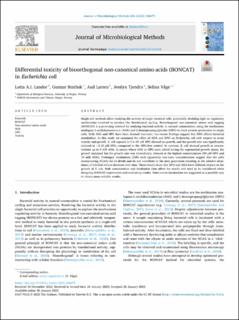| dc.contributor.author | Landor, Lotta Anni Ingeborg | |
| dc.contributor.author | Bratbak, Gunnar | |
| dc.contributor.author | Larsen, Aud | |
| dc.contributor.author | Tjendra, Jesslyn | |
| dc.contributor.author | Våge, Selina | |
| dc.date.accessioned | 2023-08-11T11:19:31Z | |
| dc.date.available | 2023-08-11T11:19:31Z | |
| dc.date.created | 2023-02-18T18:56:29Z | |
| dc.date.issued | 2023 | |
| dc.identifier.issn | 0167-7012 | |
| dc.identifier.uri | https://hdl.handle.net/11250/3083587 | |
| dc.description.abstract | Single-cell methods allow studying the activity of single bacterial cells, potentially shedding light on regulatory mechanisms involved in services like biochemical cycling. Bioorthogonal non-canonical amino acid tagging (BONCAT) is a promising method for studying bacterial activity in natural communities, using the methionine analogues L-azidohomoalanine (AHA) and L-homopropargylglycine (HPG) to track protein production in single cells. Both AHA and HPG have been deemed non-toxic, but recent findings suggest that HPG affects bacterial metabolism. In this study we examined the effect of AHA and HPG on Escherichia coli with respect to acute toxicity and growth. E. coli exposed to 5.6–90 μM HPG showed no growth, and the growth rate was significantly reduced at >0.35 μM HPG, compared to the HPG-free control. In contrast, E. coli showed growth at concentrations up to 9 mM AHA. In assays where AHA or HPG were added during the exponential growth phase, the growth sustained but the growth rate was immediately reduced at the highest concentrations (90 μM HPG and 10 mM AHA). Prolonged incubations (20h) with apparently non-toxic concentrations suggest that the cells incorporating NCAAs fail to divide and do not contribute to the next generation resulting in the relative abundance of labelled cells to decrease over time. These results show that HPG and AHA have different impact on the growth of E. coli. Both concentration and incubation time affect the results and need to be considered when designing BONCAT experiments and evaluating results. Time course incubations are suggested as a possible way to obtain more reliable results. | en_US |
| dc.language.iso | eng | en_US |
| dc.publisher | Elsevier | en_US |
| dc.rights | Navngivelse 4.0 Internasjonal | * |
| dc.rights.uri | http://creativecommons.org/licenses/by/4.0/deed.no | * |
| dc.title | Differential toxicity of bioorthogonal non-canonical amino acids (BONCAT) in Escherichia coli | en_US |
| dc.type | Journal article | en_US |
| dc.type | Peer reviewed | en_US |
| dc.description.version | publishedVersion | en_US |
| dc.rights.holder | Copyright 2023 The Author(s) | en_US |
| dc.source.articlenumber | 106679 | en_US |
| cristin.ispublished | true | |
| cristin.fulltext | original | |
| cristin.qualitycode | 1 | |
| dc.identifier.doi | 10.1016/j.mimet.2023.106679 | |
| dc.identifier.cristin | 2127229 | |
| dc.source.journal | Journal of Microbiological Methods | en_US |
| dc.identifier.citation | Journal of Microbiological Methods. 2023, 206, 106679. | en_US |
| dc.source.volume | 206 | en_US |

